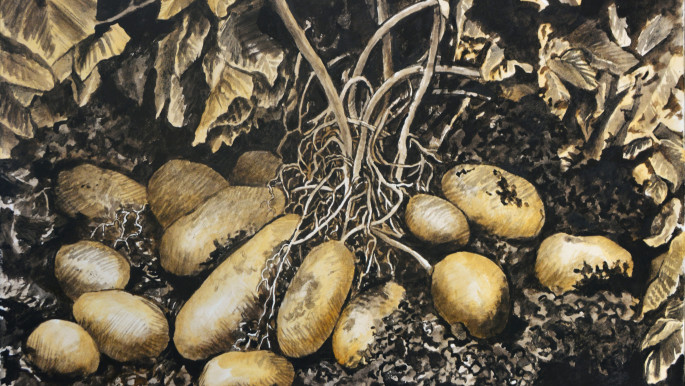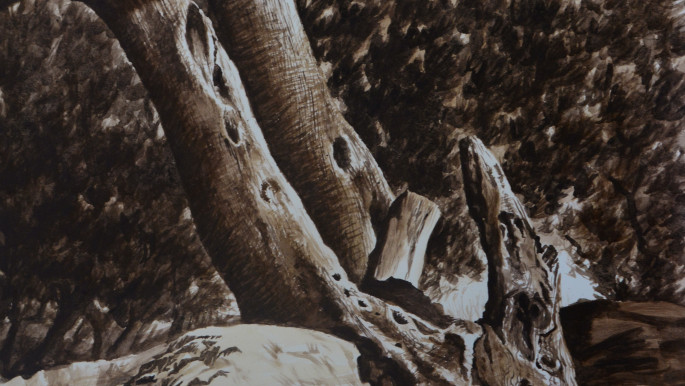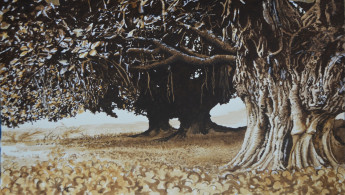From the rust of death, a rebirth: The artist using 9/11 detritus for peace-affirming art
Known for examining the targeted destruction of culture during wartime, British artist and sculptor Piers Secunda has visited countries such as Northern Iraq and moulded the Islamic State group (IS) damaged sculptures in the Mosul Museum.
The work produced were then displayed in the 2019 exhibition What Remains at London's Imperial War Museum, part of a series of exhibitions named Culture Under Attack.
More recently, Secunda's work has been, and continues to be, exhibited at the Ashmolean Museum in Oxford. The commission, named Damage Field, which features in the exhibition Owning the Past: From Mesopotamia to Iraq has been inspired and produced by a laser scanning and 3D printing of the Ashmolean's Assyrian relief resting in the Welcome Space, in front of the Information Desk on the ground floor.
Materials used for the commission include casts Secunda made in industrial floor paint, using broken stone texture moulded by the artist from IS-smashed Assyrian sculptures inside the Mosul Museum in 2018.
One overarching aspect of Secunda's work is that in order to document the devastation of culture, travel to the area of interest must take place. In his own words, Secunda told The New Arab: "It is not possible to produce a work of art about a place if you do not know the ins and outs of the place you're working on.
"Finding people who can help facilitate my journey to a place is also important," Secunda added.
 |
Materials used include casts Secunda made in industrial floor paint, using broken stone texture moulded by the artist from IS-smashed Assyrian sculptures inside the Mosul Museum in 2018 |  |
Within the context of What Remains, for example, such assistance has included collaborating with former Culture Minister of Iraq Fryad Rwandzi and the Iraqi Army, who helped Secunda in his journey to Mosul in 2018.
Regarding Secunda's current project, the artist, due to Covid-19 pandemic, knew that travelling to Abbottabad, Pakistan was not an option. At present, Abbottabad, which was where Osama bin Laden's compound was based is a secure area.
Given the circumstances, Secunda commissioned two photographers to help him capture the key focus of his current project: the natural surroundings located nearby to the Abbottabad compound. As can be seen in Secunda's drawings, surroundings include potatoes, fields heavy with crops, and edged with Poplar and Banyan trees.
The theme of Secunda's current project is one of remembrance. By using rust ink from a 9/11 steel beam and specifically choosing to draw surroundings located near bin Laden's compound in Abbottabad, Secunda's choice of material and location have a connection in terms of the events of 9/11 in New York.
As is well known, Al-Qaeda, a terrorist group founded by bin Laden, claimed responsibility for the attacks which killed 2,977 Americans.
Rather than focusing on the memory of pain, grief, and loss, Secunda, through his drawings, captures the memory of the renewal of life which occurred after the attack.
Elaborating on this concept further, Secunda explained that: "There are fields next to bin Laden's compound, such as cabbage, potato, and wheat fields. Here, life is continually being renewed via the soil in the same way that life was renewed in the US as new buildings appeared and via the distribution of 9/11 steel beams following the attack."
 |
By using rust ink from a 9/11 steel beam and specifically choosing to draw surroundings located near bin Laden's compound in Abbottabad, Secunda's choice of material and location have a connection in terms of the events in New York |  |
Secunda's explanation is clear and can best be understood as ideas effectively binding together through the ink to become images which have a resonance to the moments of the 9/11 attack.
In addition, Secunda's explanation also tells the wider audience about the continuation of life and the long running nature of the natural world and its renewal. So, in the context of the potato field and tree drawings, for example, its message is to address the continuation of life and how even though passing moments have occurred, the world carries on.
 |
|
| 9/11 Steel Beam Rust Drawing (Potatoes) 2021 Steel beam rust ink on paper 56 x 76cm (courtesy of Piers Secunda) |
 |
|
| 9/11 Steel Beam Rust Drawing (Root Over Rock) 2021 Steel beam rust ink on paper 76 x 56cm (courtesy of Piers Secunda) |
As Secunda mentions, 9/11 steel beams were distributed across the US. After the events, the 9/11 Memorial in New York asked people across the US if they wanted a memorial in the form of a piece of steel from the World Trade Center building complex where the attacks took place.
According to Secunda, steel beams were specifically reserved for town halls, government buildings, and fire stations. Whilst Secunda was living in New York, the artist visited a local fire station close by to where he was living and by chance, extremely cold weather conditions resulted in an opportunity for Secunda: collecting the flakes of rust dropping off the steel. At this point, Secunda realised that the rust could then be developed into ink which he could then use for future art projects.
Transforming the steel beam rust into an ink is a skill which requires technical expertise. First, the ink is developed via the procedure of grinding the steel beam rust into a very fine powder using a pestle and mortar.
 |
Secunda realised that the rust could then be developed into ink which he could then use for future art projects |  |
Once the rust has been finely grounded, the powder is mixed with high proof alcohol, thereby allowing the powder to suspend through the fluid. At this stage, when a pen or paintbrush is dipped into the fluid, the powder in suspension in the fluid is picked up and ready to be used for painting.
Before painting, however, a second chemical is required: a fixative, such as Gum Arabic. The addition of a fixative is important because when the ink will eventually be used for painting, the fixative acting as a binder ensures that the ink does not smear away like chalk would. Instead, the fixative ensures that the fluid sticks to the paper and aesthetically speaking, gives off a glossy effect.
Besides technical expertise, producing the ink also requires experimentation. With a particular focus on Secunda's current project, crucial experiments that have taken place include ink mixing to obtain specific colours ranging from light to dark tones.
Resembling watercolours that are somewhat transparent, the light ink colours need not undergo a long and calculated procedure of mixing. Obtaining dark colours, however, do.
Here, constant mixing is required to prevent the rust and the sediment of it from settling in the fluid. The darker the colour becomes, via the mixing, the coarser the surface becomes. Indeed, the ink's coarseness is a result of the fluid carrying more rust on to the paper, thereby giving a sandpaper feel when touched. In other words, the darker the texture, the more rust that is present in the ink.
In the works that Secunda has drawn so far, the variety of colours used, such as bright oranges to brown chocolate tones, has allowed the artist to create depth of field, brightness, and shadow all at one. So far, two institutions and a commercial gallery have expressed their interest in exhibiting the drawings.
Zainab Mehdi is a freelance writer and Research Assistant at the LSE Middle East Centre.
Follow her on Twitter @zaiamehdi



